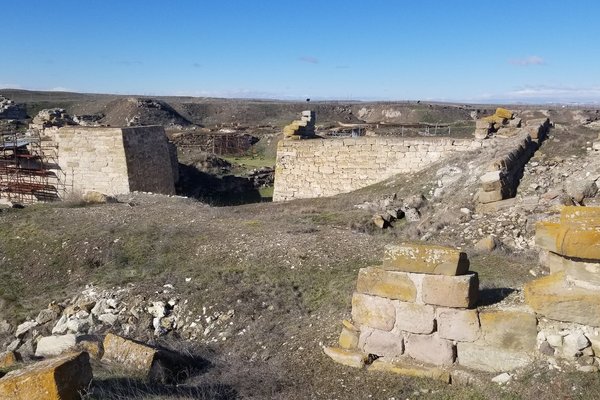Turkiye
Gordion
Gordion comprises an archeological site that best represents the Phrygian civilisation.
The remains consist of a citadel and burial mounds of Phrygian rulers, dating from the Iron Age. Its monumental fortified gate complex has been preserved. The largest of the tumuli, the “Midas Mound”, is over 50m high and has a burial chamber inside which is the oldest known standing wooden building in the world.
Community Perspective: the reviewers were pleased to see such an ancient site with noteworthy remains still in situ. It officially has only one component, but the archeological sites can be found both before and after the 'modern' village when following the main road.
Site Info
Official Information
- Full Name
- Gordion (ID: 1669)
- Country
- Turkiye
- Status
-
Inscribed 2023
Site history
History of Gordion
- 2023: Inscribed
- Inscribed
- Type
- Cultural
- Criteria
- iii
Links
- UNESCO
- whc.unesco.org
- Official
-
- muze.gov.tr — Museum website
- Related
-
- penn.museum — Gordion Archaeological Project
All Links
UNESCO.org
- whc.unesco.org — whc.unesco.org/
Official Website
- muze.gov.tr — Museum website
Related Resources
- penn.museum — Gordion Archaeological Project
News Article
- June 7, 2025 turkiyetoday.com — New tomb discovery in Gordion may belong to King Midas’ family
Community Information
- Community Category
- Archaeological site: Near Eastern
Travel Information
Free entrance
Ankara Hotspot
Recent Connections
-
Free entrance
The archaeological site is free to ente… -
Ankara Hotspot
Polatli is 36 mins by high speed train.… -
Built in the 10th century BC
"the major in situ remains revealed by …
Connections of Gordion
- Individual People
-
-
Alexander the Great
Entered Gordion in 333 BCE and - according to legend - "cut (or otherwise unfastened) the Gordian Knot: this intricate knot joined the yoke to the pole of a Phrygian wagon that stood on the acropolis of the city." (wiki)See en.wikipedia.org
-
- History
-
-
Located in a Former Capital
"capital of the Phrygian polity" (AB ev) -
Bronze Age
"Evidence suggests that the first phase of settlement came under the influence of the Hittites during the Late Bronze Age, until the collapse of that Empire, around 1200 BCE." (AB ev) -
Iron Age
"Most of the finds and the structures that emerged from the excavations at Gordion pertain to the Iron Age." (AB ev) -
Hellenistic Greece
"The advent of Alexander in 333 BCE precipitated a major change at the site, with worship of Greek deities, inscriptions in Greek, and Greek pottery all replacing their Phrygian predecessors at the site" (wiki)See en.wikipedia.org
-
Achaemenid Empire
"Following the campaigns of Cyrus the Great in Anatolia in the 540s BCE, Gordion became part of the Achaemenid Persian Empire. There is extensive evidence for the Persian siege of 546 BCE at Gordion" (wiki)See en.wikipedia.org
-
- Architecture
-
-
Mosaic art
"A building with elaborate mosaics adorning the floors of its rooms, named the Mosaic Building, was built in the 6th century BCE" (AB ev) -
Wooden architecture
"wooden burial chambers" (AB ev), the one at the Midas tomb holds is "the oldest wooden structure ever found in Anatolia, and perhaps even in the world" (see link)
-
- World Heritage Process
-
-
Perfect Inscriptions
2023 -
2 or more nominated criteria rejected by AB
4 and 6 were rejected -
Inscribed on a single criterion only
Crit iii
-
- Religion and Belief
-
-
Legends and Folk Myths
"According to ancient tradition, in 333 BCE Alexander the Great cut (or otherwise unfastened) the Gordian Knot: this intricate knot joined the yoke to the pole of a Phrygian wagon that stood on the acropolis of the city. " (wiki) -
Cult of Cybele
Painted House: "excavations revealed fragments of painted plaster and friezes decorated with human figures – mainly women but also athletes and birds. The friezes are rare depictions of Phrygian women. The building was probably a shrine of the goddess Matar." (AB ev) Matar Kubileya/Kubeleya is ancient Phrygia's only known goddess and the origin of the Cybele cult.See en.wikipedia.org
-
- Constructions
-
-
Tumuli
"Surrounding the Citadel Mound and the Lower and Outer Towns, more than one hundred tumuli – earthen mounds protecting the burials of the ruling class – dot the landscape of Gordion. Their size is variable, from small humps on the ground to large-scale mounds, such as the tumulus known as the Midas Mound" (AB ev)
-
- Timeline
-
-
Built in the 10th century BC
"the major in situ remains revealed by decades of archaeological investigations are associated with the emergence and flourishing of the Phrygian culture, between the 10th and the 6th centuries BCE" (AB ev)
-
- WHS Hotspots
-
-
Ankara Hotspot
Polatli is 36 mins by high speed train. Needs a taxi for the remaining 18km to the site.
-
- Visiting conditions
-
-
Free entrance
The archaeological site is free to enter. The museum & Midas mount require a fee.
-
News
- turkiyetoday.com 06/07/2025
- New tomb discovery in Gordion may …
Recent Visitors
Visitors of Gordion
- Alexander Barabanov
- Alexander Lehmann
- A. Mehmet Haksever
- Atila Ege
- Bill Koo
- Bin
- Can SARICA
- Corinne Vail
- Dimitar Krastev
- Els Slots
- Fan Yibo
- Hadrianus
- Harry Mitsidis
- henryjiao18
- Hubert
- Hughes1920
- Ivan Rucek
- Janos
- Jarek Pokrzywnicki
- Jeffrey Chai
- Judit Andrea Juhász
- Juha Sjoeblom
- Knut
- Loic Pedras
- Lukasz Palczewski
- Luke LOU
- Maciej Gil
- Martina Rúčková
- Milan Jirasek
- Nick M
- Nihal Ege
- Patrik
- Paul Schofield
- Randi Thomsen
- Roger Ourset
- Roman Bruehwiler
- Stanislaw Warwas
- Svein Elias
- Szucs Tamas
- Tarquinio_Superbo
- Thomas Buechler
- Thomas van der Walt
- Tim Allen
- tony0001
- Wojciech Fedoruk
- Yevhen Ivanovych
- Zoë Sheng
- Zos M
Community Reviews
Show full reviews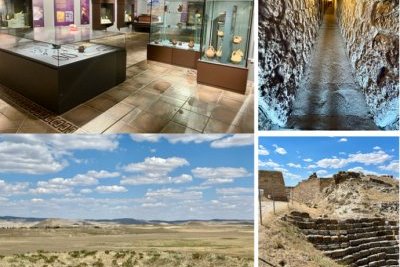
Gordion is Turkey's latest addition to the UNESCO World Heritage list as of June 2024 and one of the easiest to reach, thanks to the high-speed trains ("Yüksek Hızlı Tren"). While previous reviews have focused on its historical significance, I will concentrate on the logistics.
I started my trip from Istanbul, where my family lives. If you will do the same, then I have an important tip for you: book your train tickets at least a week in advance. Trains often sell out 3-4 days before departure, as I discovered the hard way. I managed to find two tickets in separate wagons just four days before my planned trip. The fare from Istanbul to Eskişehir was 280 TL (7.7 euros), and from Eskişehir to Polatlı, it was 145 TL (3.8 euros). Note that prices increased by 25% in July 2024 after my trip.
The physical heritage at Gordion isn't extensive; a visit, including the museum, can take around 2.5-3 hours. Add an hour if you plan to eat in the city. That's the maximum time needed in Polatlı.
Since summer days are long, we first visited Eskişehir, a lively and modern university city. Eskişehir also boasts a tentative World Heritage site, Odunpazarı, a beautifully renovated historical area from the Seljuk and Ottoman periods. We began our day with "Çi Börek," a pastry filled with ground meat, at "Kırım Tatar Kültür Çi Börek Evi," accompanied by "ayran" or Turkish tea. After a city tour, we took the …
Keep reading 0 comments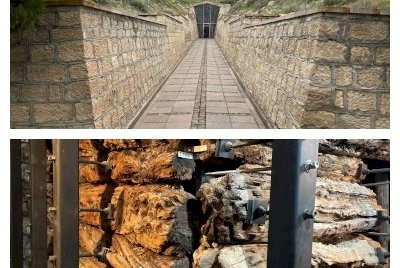
Turkey has a good track record in nominating ancient sites with noteworthy remains still in situ. The more complete ones concern relatively late (20th century) and careful excavations deep in Anatolia. Gordion (nominated for 2023) is another example: it was the capital and cultural center of the Phrygian civilization. The Phrygians had come to Anatolia from what is now Bulgaria and Greece.
First: what have the Phrygians ever done for us? It would be overstating to say that they were an influential tribe: after a flowering period in the 8th century BC when they ruled over large parts of Anatolia, they were overrun by the Lydians, Persians, Alexander the Great, Celts and Romans. Still, there are two terms in modern English that remember them: the Gordian Knot and the Midas touch.
The site of Gordion lies deep in the countryside, in what looks like an impoverished area. While driving up there I noticed dozens of people poking around in the fields with sticks – were they looking for bird eggs or mushrooms?
The archaeological site doesn’t seem to draw many visitors, I only encountered three other cars on Saturday morning. The area that is open to visitors consists of the museum, the Midas Mount across the street and the remains of the citadel on the other side of town. The entrance fee for the museum/mount combination still is a modest 40 TL, and there is none at the ruins.
The museum is small and already ageing, …
Keep reading 0 comments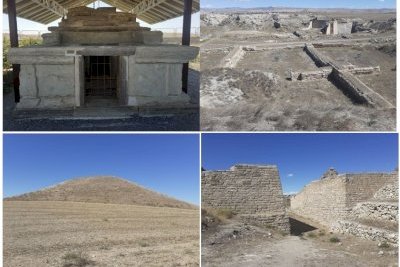
Site visited in September, 2022. Turkish candidate for inscription in 2022. Huge chances as the area was once the capital of powerful Phrygian Kingdom traces of which are still visible. They are located within and near modern Turkish village of Yassıhüyük.
While you approach the village you can spot a lot of artificial hills, some as high as 30 meters. They are mounds covering graves of Phrygian rulers and Hellenistic elite. The biggest of them is located just outside the village, next to Gordion Museum. And probably , museum is the best starting point to explore the area not only because of the necessity to buy a ticket but also because of valuable information and historical context you may get while visiting the museum. It contains artefacts from all prehistorical and ancient periods of human settlement in the area. Outside the main building but still within museum premises there are larger objects (tombs, mosaics) taken from places nearby and reconstructed.
On the other side of the main road there is an entrance to Midas Tomb (same ticket), the second biggest mound of Turkey. It was named after Midas although recent studies mostly assign it to Midas father, Gordias. Whoever it was the whole tomb is quite imposing. Inside the tomb, there is original wooden structure covering the tomb. Main corridor leading to the tomb was constructed by Turkish engineers in the 50-ties of XX century.
Main excavations and former Phrygian capital are located on other side of …
Keep reading 0 comments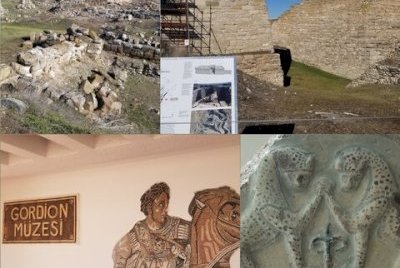
Big yes! Surprised I'm the first to review this, seeing that it's potentially inscribed soon. At first it seems like a generic museum with a mount, but it's actually one of the most important places in history, having been settled for almost 4,000 years including by Hittites, Greeks, Romans, and many more. The amount of variety this culture went through is astounding. The museum isn't very big and not spectacular but gives you a good idea about that. I'm also happy they haven't shifted all the goodies to a museum in Ankara.
Speaking of, it's an hour away from the outskirts of Ankara (add A LOT more time if you are still going through that traffic-laden capital) in a small farming village. It's a nice village though, not the one that has sheep herds and cow dung all over the place. If you are coming from the West or stayed on the D road you would hit the outdoor site first. The small roads coming from the East were perfectly fine, only very few potholes and the one that goes directly south from the site to the D road was almost worst. It's free by the way so if you are really tight on the budget just see the antique city ;)
The entrance to the museum is cheap though, less than a Euro, and gives you access to the museum and the tumulus across the street. The MM tumulus isn't much to look at, containing a strong …
Keep reading 0 comments
